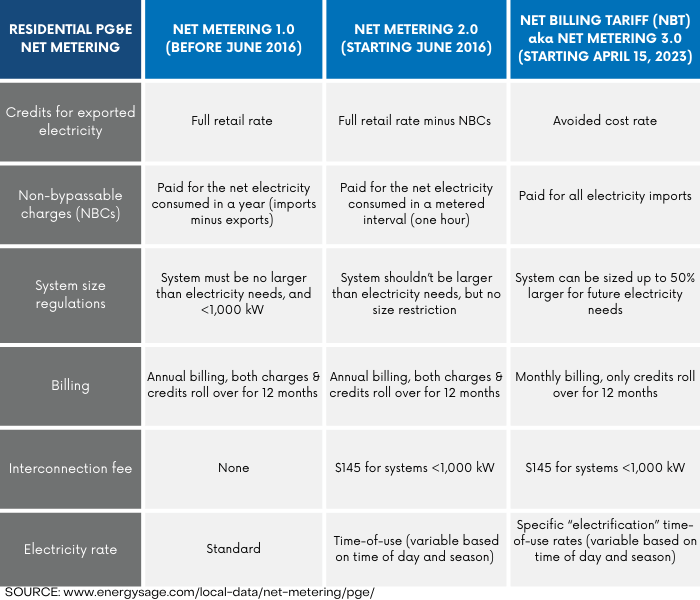Pacific Gas & Electric’s (PG&E) net metering program allows customers with grid-tied solar to earn credits for the excess electricity generated by their solar system. While these credits can be applied during times when your solar system isn’t generating enough power to meet your electricity demands, it’s important to note that you should not rely on net metering as a means to generate extra income. Your solar system should be sized to align with your current or anticipated electricity needs, and not oversized excessively.
Where is Net Metering offered for PG&E customers?
PG&E provides services to a vast region of California, extending from Bakersfield in the south to just below the Oregon border, reaching over 5 million households. The company offers net metering to nearly all customers, with a few exceptions in parts of San Francisco and Oakland. To determine your eligibility, visit PG&E’s net metering requirements page.
What Are PG&E’s Current Rates and Prices for Net Metering?
Net metering rates in PG&E’s territory depend on your property’s electricity rate structure. Essentially, for each kilowatt-hour (kWh) you feed back to the grid, you get a credit on your bill for the full retail value of that kWh, minus a few cents for non-bypassable charges (NBCs), which fund environmental benefit programs that all PG&E customers pay for.
The net metering program has seen changes over time:
- Net Metering 1.0 (before June 2016): Credits for exported electricity were given at the full retail rate.
- Net Metering 2.0 (starting June 2016): Credits were given at the full retail rate minus NBCs.
- Net Metering 3.0 – Named the Net Billing Tariff (starting April 15, 2023): Credits will be given based on the “avoided cost rate,” significantly lowering the reimbursement for solar energy sent to the grid by about 75%.
Here’s a quick comparison:
Is there a cap on PG&E’s Net Metering?
There is currently no cap on net metering in the PG&E territory in California.
What differentiates PG&E’s Net Metering from other California utility companies?
While the net metering program for PG&E is similar the other large utility companies in the state (SDG&E and SCE), the requirement to enroll in time-of-use (TOU) rates is a big differentiator from the many utilities throughout the state. The TOU rates directly impact the savings potential for homeowners with solar. Despite credits being lower during peak hours, homeowners can still reduce their monthly electric bills by taking advantage of a well designed system and the addition of battery backup solutions.
What Will Happen to My PG&E Net Metering Bill Credits?
If your solar panel system is adequately sized to meet your annual electricity needs, you may experience fluctuations in electricity production throughout the year. During months when your system generates excess electricity, you will accrue bill credits that can be utilized in subsequent months. Should your annual production exceed your consumption, you will be credited at the Net Surplus Compensation Rate (NSCR), which PG&E calculates monthly based on the market price of electricity. Your 12-month credits will be based on the average rate during that month.
PG&E Solar Interconnection Policies and Costs
To connect your solar panels to the grid, it is necessary to submit an interconnection request. This process ensures that PG&E is informed of your solar system and confirms that it is safe to operate. As your solar installer, we will handle this process for you and currently cover the standard $145 interconnection application fee. Once we submit your pre-application, the primary PG&E account owner will receive an email with the Net Metering and Customer Authorization form to docusign and grant authorization for our team to process the application on your behalf.
Conclusion
Having a clear understanding of PG&E’s net metering policies can enhance your ability to maximize your solar investment. With the recent changes to PG&E’s solar billing and net metering, it’s especially important explore the advantages of adding solar energy storage for use during peak hours. Give us a call today, or sign up below and one of our Solar Energy Consultants will create a custom proposal for your home and answer any questions you have.

